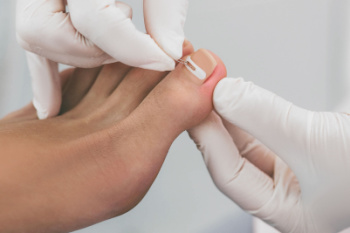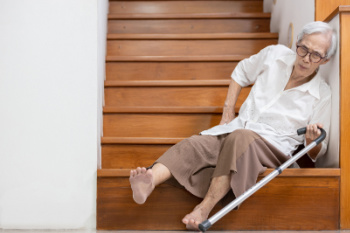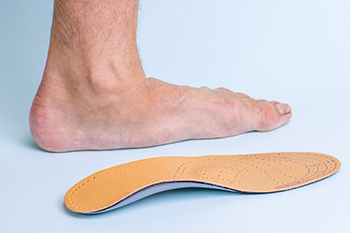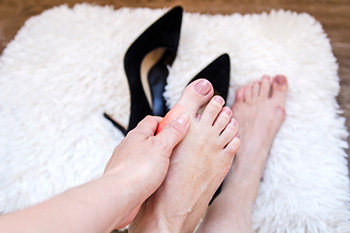Items filtered by date: December 2024
Sports Related Ingrown Toenails

Ingrown toenails occur when the edges of a toenail grow into the surrounding skin, causing pain, redness, and swelling. Certain activities, like ballet or football, can increase the risk of developing ingrown toenails. In ballet, the pressure from pointe work can cause the toenails to compress against the shoe, while football players often wear tight cleats that crowd the toes. These tight shoes, combined with repetitive movements, can lead to nail damage and ingrown toenails. Other causes include improper nail trimming such as cutting them too short or rounding the edges, injury, or genetic factors that make the toenails more prone to growing into the skin. If left untreated, ingrown toenails can become infected and lead to more serious complications. Visiting a podiatrist is key to proper diagnosis and treatment. This type of doctor can safely remove the ingrown nail, prevent or treat infection, and offer advice on proper nail care and footwear to avoid recurrence. If you have an ingrown toenail, it is suggested that you schedule an appointment with a podiatrist.
Ingrown toenails may initially present themselves as a minor discomfort, but they may progress into an infection in the skin without proper treatment. For more information about ingrown toenails, contact Harris Greenberger, DPM of Fairfield County Foot Surgeons. Our podiatrist can provide the care you need to keep you pain-free and on your feet.
Ingrown Toenails
Ingrown toenails are caused when the corner or side of a toenail grows into the soft flesh surrounding it. They often result in redness, swelling, pain, and in some cases, infection. This condition typically affects the big toe and may recur if it is not treated properly.
Causes
- Improper toenail trimming
- Genetics
- Improper shoe fitting
- Injury from pedicures or nail picking
- Abnormal gait
- Poor hygiene
You are more likely to develop an ingrown toenail if you are obese, have diabetes, arthritis, or have any fungal infection in your nails. Additionally, people who have foot or toe deformities are at a higher risk of developing an ingrown toenail.
Symptoms
Some symptoms of ingrown toenails are redness, swelling, and pain. In rare cases, there may be a yellowish drainage coming from the nail.
Treatment
Ignoring an ingrown toenail can have serious complications. Infections of the nail border can progress to a deeper soft-tissue infection, which can then turn into a bone infection. You should always speak with your podiatrist if you suspect you have an ingrown toenail, especially if you have diabetes or poor circulation.
If you have any questions, please feel free to contact our office located in Norwalk, CT . We offer the newest diagnostic and treatment technologies for all your foot care needs.
Tips for Preventing Falls in Seniors

Falls are a common risk among seniors and can lead to serious injuries, including fractures and hospitalization. Foot problems, such as weakness in the ankles, instability in the toes, or wearing improper footwear, significantly increase the likelihood of falls. Falls among seniors can often result from reduced foot strength or balance issues that stem from conditions like arthritis or neuropathy. A podiatrist can play a vital role in preventing falls in this age group by addressing foot-related concerns. This foot doctor can evaluate gait and recommend proper footwear that provides better grip and support. A podiatrist also can treat or manage other conditions that affect stability, such as corns, bunions, or poorly fitted orthotics. Regular checkups can help identify problems early, improve mobility and reduce the risk of falling. Maintaining strong, stable feet and ankles is essential for safety and independence among seniors. If you are a senior at risk of falling, it is suggested that you schedule an appointment with a podiatrist for guidance.
Preventing falls among the elderly is very important. If you are older and have fallen or fear that you are prone to falling, consult with Harris Greenberger, DPM from Fairfield County Foot Surgeons. Our podiatrist will assess your condition and provide you with quality advice and care.
Every 11 seconds, an elderly American is being treated in an emergency room for a fall related injury. Falls are the leading cause of head and hip injuries for those 65 and older. Due to decreases in strength, balance, senses, and lack of awareness, elderly persons are very susceptible to falling. Thankfully, there are a number of things older persons can do to prevent falls.
How to Prevent Falls
Some effective methods that older persons can do to prevent falls include:
- Enrolling in strength and balance exercise program to increase balance and strength
- Periodically having your sight and hearing checked
- Discuss any medications you have with a doctor to see if it increases the risk of falling
- Clearing the house of falling hazards and installing devices like grab bars and railings
- Utilizing a walker or cane
- Wearing shoes that provide good support and cushioning
- Talking to family members about falling and increasing awareness
Falling can be a traumatic and embarrassing experience for elderly persons; this can make them less willing to leave the house, and less willing to talk to someone about their fears of falling. Doing such things, however, will increase the likelihood of tripping or losing one’s balance. Knowing the causes of falling and how to prevent them is the best way to mitigate the risk of serious injury.
If you have any questions, please feel free to contact our office located in Norwalk, CT . We offer the newest diagnostic and treatment technologies for all your foot care needs.
Painful Flat Feet

Flat feet, sometimes called fallen arches, occur when the arches of the feet collapse, causing the entire sole to touch the ground. This condition can lead to pain in the midfoot, especially after standing or walking for long periods. Other symptoms include swelling, foot fatigue, and even pain in the lower legs, knees, or lower back, as flat feet can affect your posture and gait. A variety of factors, including genetics, injury, obesity, or conditions like arthritis can cause flat feet. Over time, the lack of proper arch support can lead to increased strain on the muscles and joints in the feet. Treatment options for flat feet often include custom orthotics, which provide better arch support, stretches, strengthening exercises, and proper footwear. In some cases, surgical intervention may be necessary. A podiatrist can evaluate your condition and recommend the best treatment plan. If you are experiencing foot pain, it is suggested that you make an appointment with a podiatrist.
Flatfoot is a condition many people suffer from. If you have flat feet, contact Harris Greenberger, DPM from Fairfield County Foot Surgeons. Our podiatrist will treat your foot and ankle needs.
What Are Flat Feet?
Flatfoot is a condition in which the arch of the foot is depressed and the sole of the foot is almost completely in contact with the ground. About 20-30% of the population generally has flat feet because their arches never formed during growth.
Conditions & Problems:
Having flat feet makes it difficult to run or walk because of the stress placed on the ankles.
Alignment – The general alignment of your legs can be disrupted, because the ankles move inward which can cause major discomfort.
Knees – If you have complications with your knees, flat feet can be a contributor to arthritis in that area.
Symptoms
- Pain around the heel or arch area
- Trouble standing on the tip toe
- Swelling around the inside of the ankle
- Flat look to one or both feet
- Having your shoes feel uneven when worn
Treatment
If you are experiencing pain and stress on the foot you may weaken the posterior tibial tendon, which runs around the inside of the ankle.
If you have any questions please feel free to contact our office located in Norwalk, CT . We offer the newest diagnostic and treatment technologies for all your foot and ankle needs.
High Heels and Bunions

High heels are fashionable but can worsen hallux valgus, commonly known as bunions. These shoes often have narrow toe boxes that squeeze the toes, forcing the big toe out of alignment and aggravating the bony bump at its base. The elevated heel shifts body weight forward, increasing pressure on the forefoot and the bunion, leading to inflammation and discomfort. High heels also alter the natural mechanics of walking, limiting toe movement and stressing the joints, which can accelerate the progression of hallux valgus. For those already experiencing bunion pain, high heels amplify friction and irritation, causing swelling and redness that make walking uncomfortable. Opting for shoes with a wider toe box and a lower heel height can help minimize pain while preserving foot health. If you have developed a bunion from wearing high heels, it is suggested that you see a podiatrist for relief options and guidance on choosing shoes that will protect against further foot damage.
High heels have a history of causing foot and ankle problems. If you have any concerns about your feet or ankles, contact Harris Greenberger, DPM from Fairfield County Foot Surgeons. Our podiatrist can provide the care you need to keep you pain-free and on your feet.
Effects of High Heels on the Feet
High heels are popular shoes among women because of their many styles and societal appeal. Despite this, high heels can still cause many health problems if worn too frequently.
Which Parts of My Body Will Be Affected by High Heels?
- Ankle Joints
- Achilles Tendon – May shorten and stiffen with prolonged wear
- Balls of the Feet
- Knees – Heels cause the knees to bend constantly, creating stress on them
- Back – They decrease the spine’s ability to absorb shock, which may lead to back pain. The vertebrae of the lower back may compress.
What Kinds of Foot Problems Can Develop from Wearing High Heels?
- Corns
- Calluses
- Hammertoe
- Bunions
- Morton’s Neuroma
- Plantar Fasciitis
How Can I Still Wear High Heels and Maintain Foot Health?
If you want to wear high heeled shoes, make sure that you are not wearing them every day, as this will help prevent long term physical problems. Try wearing thicker heels as opposed to stilettos to distribute weight more evenly across the feet. Always make sure you are wearing the proper shoes for the right occasion, such as sneakers for exercising. If you walk to work, try carrying your heels with you and changing into them once you arrive at work. Adding inserts to your heels can help cushion your feet and absorb shock. Full foot inserts or metatarsal pads are available.
If you have any questions please feel free to contact our office located in Norwalk, CT . We offer the newest diagnostic and treatment technologies for all your foot and ankle needs.
How Aging Can Affect the Feet

As people age, the feet undergo changes that can lead to discomfort and mobility challenges. Years of wear and tear, in addition to conditions such as arthritis or diabetes, can cause pain, swelling, and stiffness. The natural thinning of the fat pads that cushion the feet may increase foot pain when walking and standing. Furthermore, reduced bone density, particularly seen in post-menopausal women, can increase the risk of stress fractures. Joint inflammation and nerve damage, often associated with aging, can also affect balance and increase the likelihood of falls. Poor circulation, common in older adults, can delay healing and make the feet more susceptible to injuries or infections. A podiatrist can assess the type of foot pain you have and recommend custom orthotics, certain medication to relieve pain, or ways to enhance mobility. If you are a senior suffering from foot pain, it is suggested that you schedule an appointment with a podiatrist for a diagnosis and treatment options.
Proper foot care is something many older adults forget to consider. If you have any concerns about your feet and ankles, contact Harris Greenberger, DPM from Fairfield County Foot Surgeons. Our podiatrist can provide the care you need to keep you pain-free and on your feet.
The Elderly and Their Feet
As we age we start to notice many changes in our body, but the elder population may not notice them right away. Medical conditions may prevent the elderly to take notice of their foot health right away. Poor vision is a lead contributor to not taking action for the elderly.
Common Conditions
- Neuropathy – can reduce feeling in the feet and can hide many life-threatening medical conditions.
- Reduced flexibility – prevents the ability of proper toenail trimming, and foot cleaning. If left untreated, it may lead to further medical issues.
- Foot sores – amongst the older population can be serious before they are discovered. Some of the problematic conditions they may face are:
- Gouging toenails affecting nearby toe
- Shoes that don’t fit properly
- Pressure sores
- Loss of circulation in legs & feet
- Edema & swelling of feet and ankles
Susceptible Infections
Diabetes and poor circulation can cause general loss of sensitivity over the years, turning a simple cut into a serious issue.
If you have any questions please feel free to contact our office located in Norwalk, CT . We offer the newest diagnostic and treatment technologies for all your foot and ankle needs.

